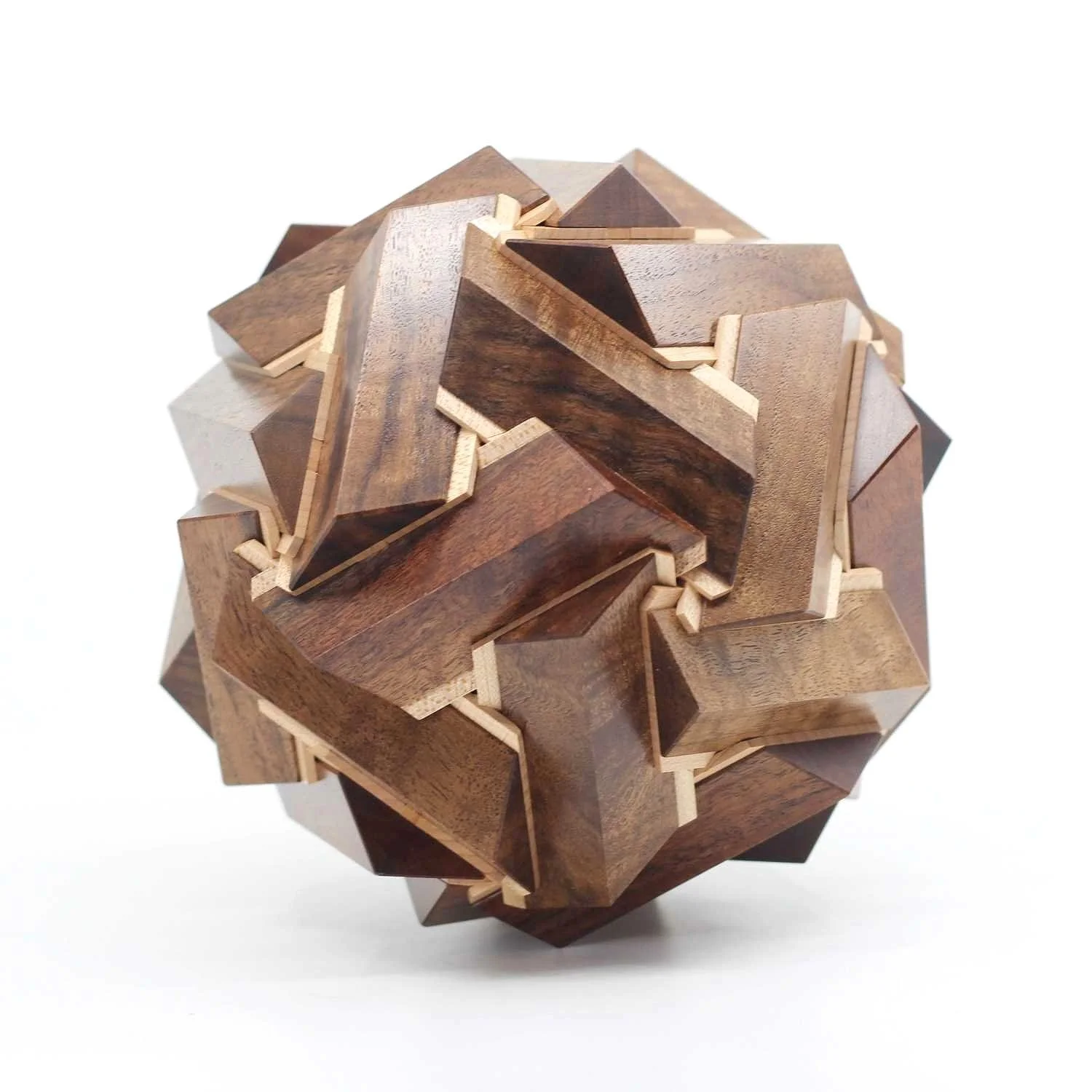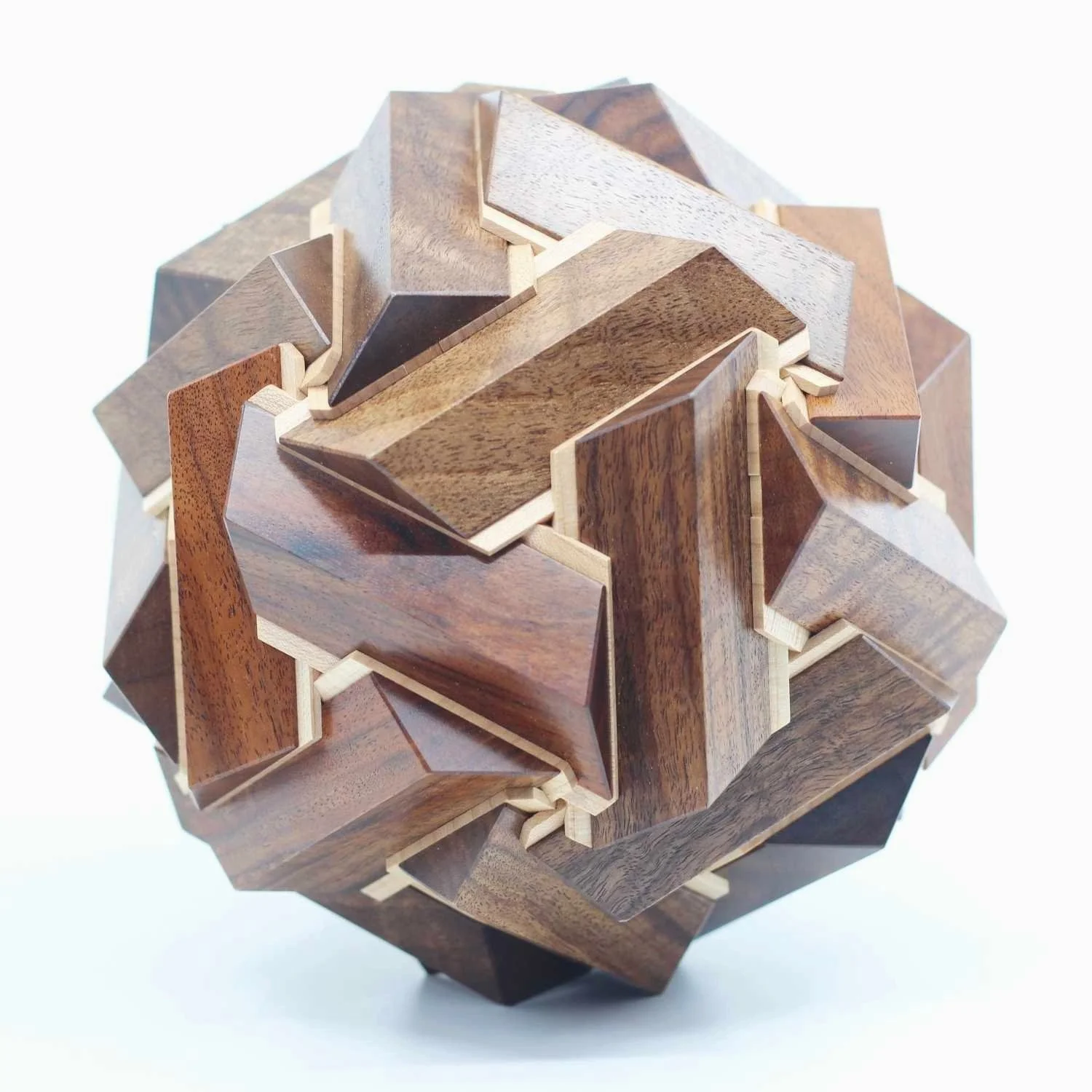Prickly Situation
Hedgehog
The fox has many tricks. The hedgehog has but one. But that is the best of all. - Ralph Waldo Emerson
Hedgehogs, the cute little mammals easily recognized by their many keratin quills, have changed very little over the past fifteen million years. Their main line of defense, to roll into a tight spiky ball with no vulnerable flesh exposed, appears to have been extremely effective. Hedgehogs are also a set of human genes, whose signaling is critical for cell development, proliferation, and survival. Hedgehogs are in our DNA. I don’t know if this is why they capture our imagination so pointedly, but the internet seems to love them.
Hedgehog by Kagen Sound
Kagen Sound loves them too, and has named his most recent masterpiece after them. Whenever Kagen embarks on a new project, he tries to push himself into trying something novel. It can be based on using a new material, a new shape, new tools, or a new function or mechanism. “How can I push the limits of how wood can move?” he asks. In his Plus Box, for example, the box itself takes a traditional shape. It is the mechanism that is unusual, pushing limits on function and sound. With the Hedgehog, he turned to shape as the boundary defying challenge. The project began with a rhombic triacontehedron – “could I even make one?” he wondered. Few of us would doubt it. The fascinating shape has been a sirens call for many puzzle makers, including the likes of Stewart Coffin and Jane Kosticks. Kagen discovered that the set of thirty diamonds (rhombic faces) with the magic angles 63.43 and 36 degrees could wedge together at the joints, with 60 edges and 32 vertices, so that no glue is needed to hold the “ball” all together. The diagonals on these thirty special rhombic faces are interesting as well; their ratio is φ (phi), the golden ratio – these are “golden rhombi”.
Building the prototype revealed new patterns and designs for the wedged “chunks”, as he calls them, to be arrayed and to move. The puzzle developed organically from the shape and movements. The hardest part of the design process was to make it a “box”, which suddenly introduced all sorts of restrictions that rippled across the entire structure. Cutting a lid changed the symmetry and destabilized the whole, creating new design and construction puzzles to solve.
trying a new angle …
Kagen has always been fascinated with woodworking, using hand tools in his basement as a kid to craft toys and traditional puzzle boxes. He could never get enough from his high school woodshop classes. His degree in mathematics only added to the fascination. The Hedgehog felt like a math challenge to him, as he worked to get the angles and numbers precisely right. He zeroed in quickly, only making a few versions and discovering things worked well right away.
Kagen started building the puzzle with no special name in mind (he feels that naming things can also be a challenge), but eventually began thinking of it as a particle, or molecule; it also reminded him of pollen, or a spore. Perhaps a meteor, he thought - but no, that name was taken. He let it marinate until one day, he found himself looking at photos of hedgehogs … and the idea of “uncurling” a sleeping hedgehog was too much fun to resist.
One small detail frustrated him more than expected – the process of finishing the small parts. Layering and sanding, the edges starting to round at the corners, but wanting a crisp, level, planer look, proved quite a new challenge and learning process. An old furniture making mentor gave him some useful advice on managing the stunning Buckeye Burl used in a few of the pieces, a wood which has structural inconsistency and varying density. “Sometimes you think you know what you are doing with wood. Then you make three hundred parts and need a new solution.” Among many fine details found in Kagen’s work, his exquisite finishes are also renown, and mirror those found in fine musical instruments. On this project he learned a new lesson, to protype the finish as well.
wedge salad
The Hedgehog is a dauntingly beautiful object d’art, so much so that many who have experienced it have been afraid to dismantle and reconfigure it, despite the intentions of the puzzle maker. There are two different settings of difficulty built in. Anyone brave enough to solve and dismantle it will discover a secret that Kagen included, and something he has never done before on a puzzle. He placed numbered labels on the pieces inside, so it can’t be mixed up. There is actually nothing to fear. He realized that he was alone on his “idea island”, knowing exactly where all the pieces go, but he needed to help others know as well, now, and in the future. He wants his pieces to be timeless, and self-contained, so that future puzzle anthropologists won’t need an instruction manual to understand how the puzzle was meant to be constructed. He is preserving his intentions now, while making his pieces less intimidating, taking some pressure off, when needed, to allow a better user experience and enjoyment. “I am trying to make things which will last a really long time. Preserving, documenting over time, connected directly to the pieces themselves so anyone who encounters it down the line can know what to do with it.” A tireless innovator, he is always trying something new with an eye to the future.
The Quill by Frank C. Payne
Harry MacElhone was a talented craftsman, showman and businessman in the spirit world. His heyday was in the roaring twenties, at his eponymous “Harry’s New York Bar”, in Paris. His establishment, famously located at 5 Rue Daunou, was at the center of activities for bon vivants and barflies of the expat era. He also knew the power of offering his patrons a little help – he placed advertisements in the newspapers and taxicabs of Paris, with instructions to tell the driver to “take me to Sank Roo Doe Noo”. The many cocktail creations he is credited with inventing can be found in his books Harry of Ciro’s ABC of Mixing Cocktails, 1921, and Barflies and Cocktails, 1927.
quill and ink
MacElhone was clearly well versed in Negroni lore, despite its obscurity outside of Italy at the time, and is in fact credited with creating the Boulevardier variation with bourbon rather than gin for his good friend Erskine Gwynne, nephew of Andrew Carnegie and editor of the Boulevardier magazine, a sort of “New Yorker” for the Parisian crowd. Another Negroni variation can be found in MacElhone’s book, but not one he ever knew about, at least by the current name. The “Quill” cocktail only first appeared in Harry’s ABC of Mixing Cocktails, 1996 edition, where it is attributed to Frank C. Payne. There is just a subtle twist to this version, the addition of a hint of absinthe to the usual mix of gin, sweet vermouth and Campari, but that potent presence alters the drink considerably. Payne was a theater press agent whose union, the Theatrical Press Representatives of America, irregularly published a magazine named The Quill. His Negroni amplifies the herbal bitterness of the drink and adds a notable barb – for when you want an extra challenge. Don’t be afraid to deconstruct this drink and reconfigure it to suit your tastes, and try something new. Cheers!
hedge your bets
The Quill
1 oz gin (London dry)
1 oz sweet vermouth
1 oz Campari
1 barspoon absinthe
Stir ingredients with ice and strain into a favorite glass. Hedgehog lime wheel garnish optional.
explore more:






